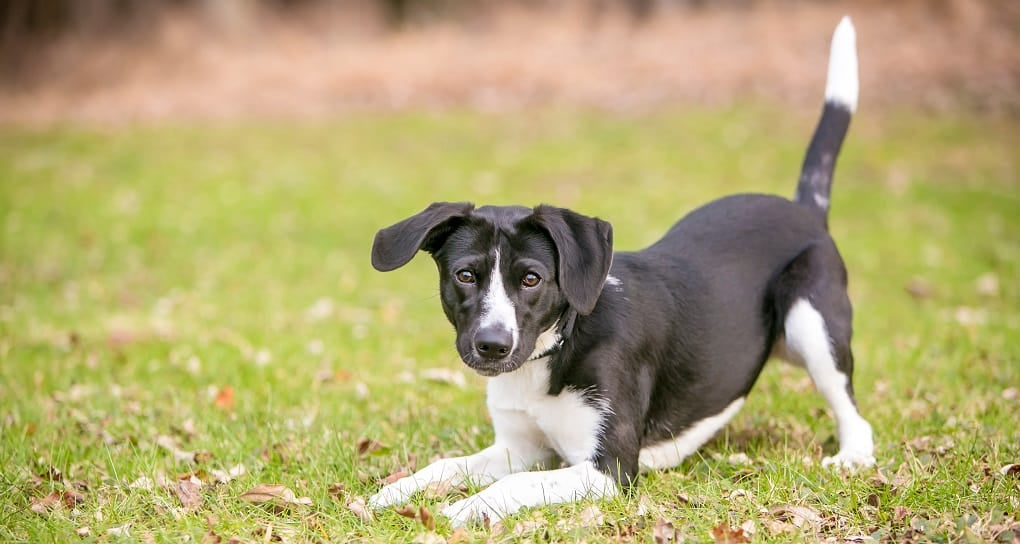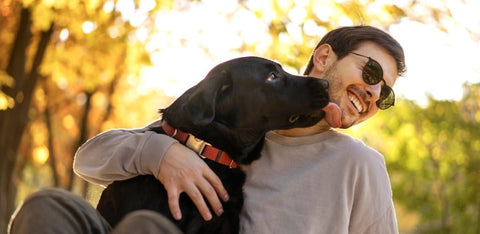

Why Do Dogs Wag Their Tails?
When you’re with your canine best friend, there’s nothing better than seeing the wag of a happy tail. They’re happy. You’re happy. It’s all just pure and uncomplicated joy.
But is there more to it than that? What are tails for? And does a wagging tail always signify happiness?
Let’s take a wiggly walk through the science and folklore of the wagging tail to see what there is to discover.
When a wagging tail is a warning
A wagging tail is not a universal sign of happiness for animals. If a cat’s waving its tail, it could be stalking some prey or you could have rubbed it up the wrong way. Time to move out of reach of those claws.
If a horse swishes its tail, it could be trying to get rid of an annoying fly, but it could also be agitated. This would be a good moment to give the horse some space.
In the doggy camp: elephants and wolves

Elephants, though, are like dogs, in that the swish of a tail from side to side indicates that the animal is happy and relaxed. But if they hold their tail still or at right angles to their body, they could be angry or frightened. Which could be handy to know if you’re on safari in the path of a herd of elephants.
As you might expect, wolves have something in common with dogs, although a wagging wolverine tail has a slightly different meaning. According to the Wolf Education and Research Center: “Generally, wolves wag their tails when there is an increase of energy or excitement occurs.”
From brain to tail: anatomy of the wag
Before we get to interpreting the subtleties of your dog’s wag, let’s take a closer look at the anatomy of the tail itself.
Your dog’s tail is actually an extension of its backbone. It usually consists of between 6 and 23 highly mobile spinal bones that are surrounded by muscle and connected to the tail bones by tendons.
Thanks to the muscles around the tail bones, your dog can move its tail in a variety of ways – including lifting it, moving it from side to side, and drawing it between its legs.
Your dog’s spinal cord contains nerves that lead from its brain to the end of its tail, with the tail containing progressively smaller pairs of spinal nerves that link the tail’s muscles to the central nervous system.
So when your dog has a thought – such as “My human’s back!” or “It’s dinner time” – nerve impulses are transmitted from the brain through the spinal cord to the muscles of the tail to generate a wag of happiness.
What’s a tail for?
Dogs use their tails for balance, as a rudder while swimming and to communicate. Tails also come in handy for swiping things off tables, giving you a friendly thwack in the legs and drumming against furniture.
During lockdown, Rolo the dachshund was so happy to be with his owners 24/7 that he sprained his tail through excessive wagging, developing ‘happy tail syndrome’
As you may have noticed, puppies don’t wag their tails as soon as they’re born. The first wag usually happens around the age of 3-4 weeks, when pups discover the need to communicate with their family. At that age, you might see them wag their tail to let their mother know they’re hungry or to tell their siblings they’ve had enough of playtime for now.
See that? Dogs are hard-wired to spot movement
In the same way that dogs’ sense of smell is much more acute than ours, their eyes are also much more sensitive to movement. So they’re extremely quick to pick up on the meaning behind the swish of another dog’s tail.
When you’re out and about on your walks, your dog will be scanning the horizon, ready to spot tail movements so they can read other dogs’ body language.
How your furry friend is feeling
More often than not, a wagging tail suggests that your pup is feeling content. But in fact your dog can communicate a sophisticated variety of messages just using its tail.
- A very slight wag can be the canine equivalent of saying a tentative, low-key hello.
- A big, swishing wag shows that your pup is feeling relaxed and friendly.
- A full circle tail wag demonstrates total exuberance and is the closest your dog will get to giving you a bear hug.
- A high, stiff tail with a tip that’s wagging fast is a sign that your dog is alert and possibly feels threatened.
- A tail held high and still can signify confidence and even aggression.
- A tail held between the legs suggests your pup is scared or stressed - try calming supplements for dogs.
Does your dog wag left or right?
Amazingly, there’s evidence that there’s a difference between a tail that wags to the right and one that wags to the left. Research from the University of Trento in Italy found that dogs wagged their tails to the right when they were happy and confident and to their left when they were frightened.
It might not be easy to make out which way your pup’s tail is wagging when you’re running behind them in the park. Interestingly, though, animals in the study were able to detect which way other dogs were waving their tails. So this may be another way that dogs are able to interpret subtle doggy body language.
Tail-free communication
But what if your dog’s tail has been docked or they’re a breed with little or no tail, such as the French bulldog or Pembroke Welsh Corgi?
In that case, you won’t be able to gauge your dog’s mood by the speed, motion or direction of their wag. You’ll have to rely on other signs such as the position of their ears, their facial expression or the way they’re holding themselves.
Equally, other dogs might have trouble interpreting your dog’s body language. Research using a robotic black Labrador (yes, really) discovered that dogs approached a robo-dog with a docked tail more cautiously than when it had a complete tail.
The lesson for pup parents? If your dog has little or no tail, you might need to monitor its interactions with other dogs more carefully.
Do you talk to yourself?
Finally, it’s quite common for us humans to talk to ourselves as we go about our day. But dogs don’t wag their tails when they’re on their own. Tails are there to communicate with us and with other dogs.
We hope this article has given you some useful insights into what all those wags really mean. If you have any videos of fantastic circular tail wags, floor-thumpers or tails that play percussion in your kitchen, please share them with us on Facebook or Instagram.





